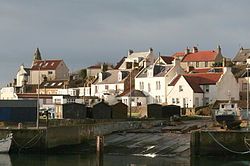St Monans
| St Monans | |
| Fife | |
|---|---|
 St Monans (west end of harbour) | |
| Location | |
| Grid reference: | NO524017 |
| Location: | 56°12’22"N, 2°45’60"W |
| Data | |
| Population: | 1,340 (2006 est.) |
| Post town: | Anstruther |
| Postcode: | KY10 |
| Dialling code: | 01333 |
| Local Government | |
| Council: | Fife |
| Parliamentary constituency: |
North East Fife |
St Monans (often spelt St Monance) is a village and parish in the East Neuk of Fife, named after the legendary Saint Monan. The village stands approximately three miles west of Anstruther.
This small picturesque community, whose inhabitants formerly made their living mainly from fishing, is now both a tourist destination situated on the Fife Coastal Path, and a close knit community with much vitality and vibrancy. The former burgh rests on a hill overlooking the Firth of Forth, with views to North Berwick, the Bass Rock and the Isle of May. St Monans contains many historical buildings, most notably the now defunct windmill (which can be visited) that once powered a salt panning industry, and a 14th-century church that sits on the rocks above the water on the western side. Approximately ½ mile west of St Monans are the remains of the once great Newark Castle, a 16th-century manor that has since fallen to ruin through cliff erosion and disrepair. In 2002, with the permission of Historic Scotland, an unsuccessful attempt to restore the castle was made.
Parish church
St Monans Church stands within its kirkyard just to the west of the village on the very edge of the sea. It has a very dramatic setting, perched on a low rock, reached over a small valley with a burn. As seen from most directions it has the sea as a backdrop. A more modern cemetery stands further westwards on the upper slopes of the little hill. This contains the local war memorial. Standing at the extreme west end of this a romantic ruin can be viewed across fields, again perched on the sea edge.
It is often said that St Monans is the church nearest the sea, and it may well Britain's closest to the waves as it is about 20 yards from the water. The church, one of the finest remaining from the Middle Ages in the Church of Scotland, was built by King David II (1329–71), initially for a small house of Dominican friars.
At the Reformation, this church became the parish kirk for the village. Though the church may never have been finished (it has a choir and transepts, with a short spire over the crossing, but lacks a nave), it has many features of architectural interest, notably the fine stone vaulting in the choir and the plain but handsome sedilia. White-washed throughout internally, the church is particularly light and attractive among ancient churches.
Major restoration to the windows and masonry was completed in March 2007.
St Monans Parish Church is linked with Largoward Parish Church. The current minister of both parish churches is the Revd Dr Donald MacEwan.
St Monans Gospel Hall
The Hall was built in 1970 and is a modern building, harled with a slate roof, situated in a raised location facing broadly west over Hope Park on the northern edge of St Monans. Prior to its construction, it was not uncommon for fishermen from St Monans to cycle to St Andrews to attend meetings at the Gospel Hall there. The current gospel preachers for St Monans Gospel Hall are Dr Bert Cargill and Mr Phillip Hughes. Gospel meetings are held at 6.00 p.m. every Sunday.
Shops, hotels, cafés and businesses
St Monans has a number of shops and businesses, including fish merchants and a fish-smokehouse. St Monans Mini Market, run by mother and daughter partnership, provides for all grocery needs. Bed and Breakfast is available in the village. There are several pubs, restaurants and cafés in the village. There is also a caravan park which attracts many visitors, a tradition that has continued from the days of the railway line.
In the industrial estate at the entrance to St Monans are the remains of the old railway station, a relic of the old East Neuk Rail Line that was shut down in the 1960s after the Beeching Axe. All that remains is the south platform which is overgrown with grass. However nearby is the station master's house, now a private residence, which stands out from the newer buildings surrounding it.
History
The village takes its name from St Monance who was killed by invading Danes in about 875. St Adrian was killed on the Isle of May in the same raid and all told 6,000 Fife Christians are said to have died. [1]
Like other small 'East Neuk' towns, St Monans is rich in vernacular fisher and merchant houses of the 17th to early 19th centuries, with characteristic old Scots features, e.g. forestairs, crow-stepped gables, datestones, pantiled roofs etc. The tradition of shipbuilding has now ceased. For over 200 years the boat builder J W Miller & Sons Ltd produced fifie fishing boats, yachts and motor launches in the village.
The author Christopher Rush grew up in the village. His autobiography "Hellfire and Herrings" describes the community as seen by a small boy in the 1940s, 1950s and earlier, and as recounted by his grandfather and other relatives.
Gallery
-
St. Monans Parish Church
-
St Monans Parish Church Interior
-
St Monans Parish Church Interior
-
Remains of Newark Castle
-
Remains of Newark Castle
-
Castle do not enter warning
-
East view from Newark Castle remains
-
St Monans Windmill
-
Isopodichnus trace fossil from the foreshore
Outside links
- http://www.stmonans.org.uk/
- http://www.eastneukwide.co.uk/tourist/st-monans.html
- http://www.electricscotland.com/history/eastneuk9.htm
- http://www.stmonanslargowardkirk.org
References
- ↑ Haswell-Smith (2004) pp. 490-94
- Haswell-Smith, Hamish (2004). The Scottish Islands. Edinburgh: Canongate. ISBN 1841954543.








